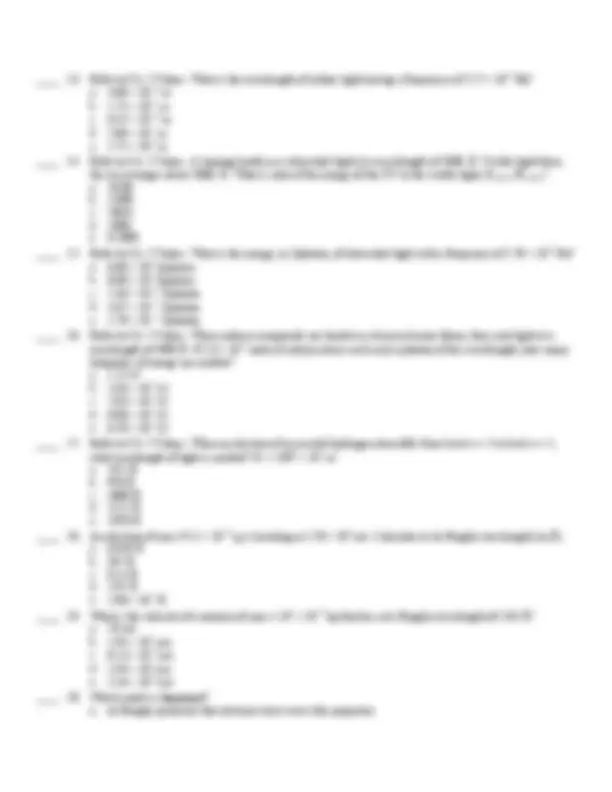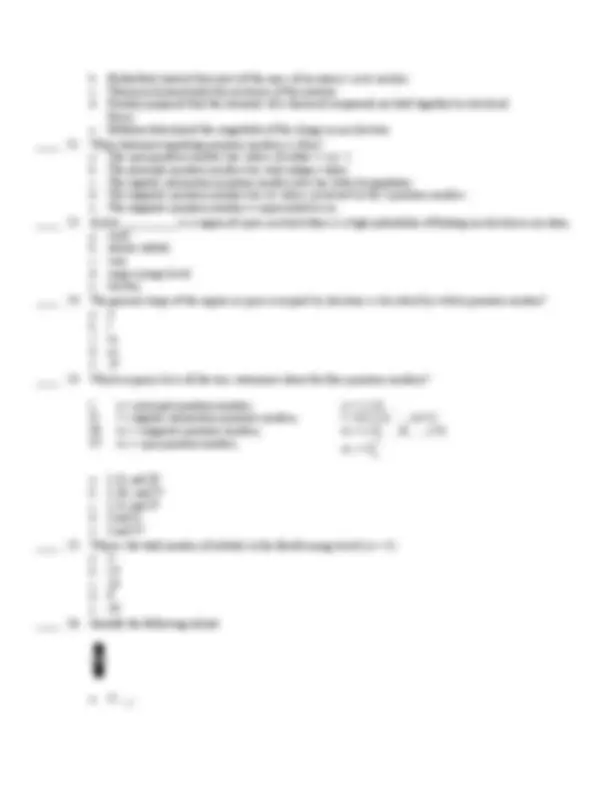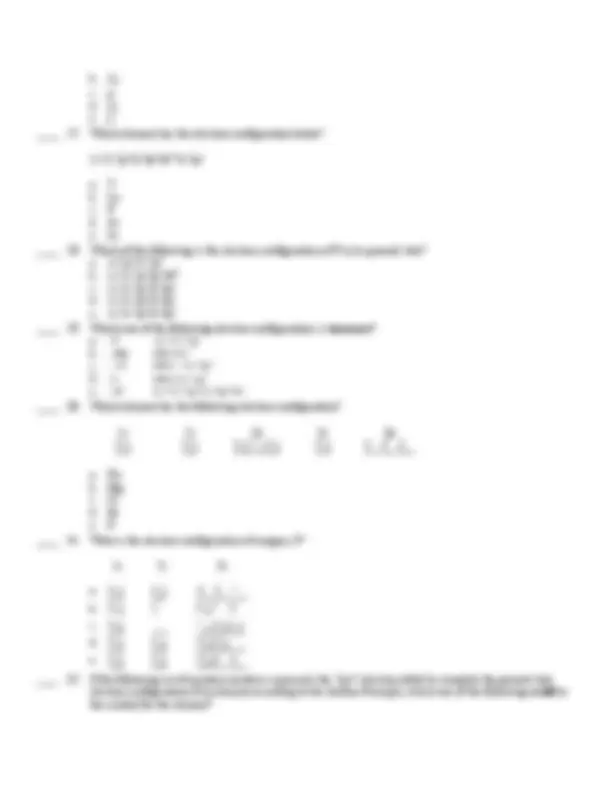





Study with the several resources on Docsity

Earn points by helping other students or get them with a premium plan


Prepare for your exams
Study with the several resources on Docsity

Earn points to download
Earn points by helping other students or get them with a premium plan
Community
Ask the community for help and clear up your study doubts
Discover the best universities in your country according to Docsity users
Free resources
Download our free guides on studying techniques, anxiety management strategies, and thesis advice from Docsity tutors
Material Type: Notes; Class: General Chemistry I; Subject: Chemistry; University: South Carolina State University; Term: Unknown 2006;
Typology: Study notes
1 / 6

This page cannot be seen from the preview
Don't miss anything!




Multiple Choice Identify the letter of the choice that best completes the statement or answers the question.
____ 1. Which of the following has a negative charge? a. nucleus b. neutron c. proton d. electron e. alpha particle
____ 2. Which statement is false? a. Ordinary chemical reactions do not involve changes in nuclei. b. Atomic nuclei are very dense. c. Nuclei are positively charged. d. Electrons contribute only little to the mass of an atom. e. The nucleus occupies nearly all the volume of an atom.
____ 3. The atomic number of an element gives the number of __________ and __________ in the atom while the mass number gives the total number of __________ and __________. a. neutrons, protons; neutrons, electrons b. neutrons, electrons; protons, electrons c. neutrons, electrons; neutrons, protons d. protons, electrons; neutrons, electrons e. protons, electrons; neutrons, protons
____ 4. The atomic number of a certain element is 19, and its atomic weight is 39. An atom of the element contains __________ protons, __________ neutrons, and the chemical symbol for the element is __________. a. 19, 19, F b. 19, 20, F c. 19, 20, K d. 20, 19, K e. none of these
____ 5. Which pair of species has the most nearly identical properties? a. b. c. d. e.
____ 6. Give the number of protons, neutrons, and electrons of the 128 Te2-^ anion. a. 52 p, 76 n, 52 e b. 52 p, 128 n, 52 e c. 76 p, 52 n, 52 e d. 52 p, 128 n, 54 e e. 52 p, 76 n, 54 e
____ 7. What is the symbol for a species composed of 38 protons, 52 neutrons, and 36 electrons?
a. 90 Kr2+ b. 90 Sr2+ c. 90 Sr d. 52 Kr e. 38 Th2+
____ 8. What is the atomic weight of a hypothetical element consisting of two isotopes, one with mass = 64.23 amu (26.00%), and one with mass = 65.32 amu? a. 65.16 amu b. 64.37 amu c. 64.96 amu d. 65.04 amu e. 64.80 amu
____ 9. A hypothetical element consists of four isotopes having the following percentage natural abundance and isotopic masses. What is its atomic weight? isotope 1: 16.06% (52.100 amu); isotope 2: 28.36% (53. amu); isotope 3: 42.60% (54.093 amu); isotope 4: 12.98% (55.090 amu). a. 53.182 amu b. 53.262 amu c. 53.314 amu d. 53.487 amu e. 53.620 amu
____ 10. A hypothetical element has an atomic weight of 48.68 amu. It consists of three isotopes having masses of 47.00 amu, 48.00 amu, and 49.00 amu. The lightest-weight isotope has a natural abundance of 10.0%. What is the percent abundance of the heaviest isotope? a. 66.0% b. 12.0% c. 18.0% d. 72.0% e. 78.0%
____ 11. The atomic weight of antimony is 121.76 amu. There are two naturally occurring isotopes of antimony. 121 Sb has an isotopic mass of 120.9038 amu and has a natural abundance of 57.40%. What is the isotopic mass of the other isotope, 123 Sb? a. 122.4 amu b. 122.9 amu c. 122.2 amu d. 123.2 amu e. 123.1 amu
Ch. 5 Values Some of the following values may be useful for solving some of the following problems.
speed of light = 3.00 × 108 m/s1 joule = 1 kg•m^2 /s^2 Planck's constant = 6.63 × 10 -34^ J•s1 Ångstrom = 1 × 10 -10^ m
____ 12. Refer to Ch. 5 Values. What is the frequency of light having a wavelength of 4.50 × 10 -6^ cm? a. (^) 2.84 × 10 -12^ s- b. (^) 2.1 × 104 s- c. (^) 4.29 × 1014 s- d. (^) 1.06 × 1022 s- e. (^) 6.67 × 1015 s-
b. Rutherford showed that most of the mass of an atom is in its nucleus c. Thomson demonstrated the existence of the neutron d. Faraday proposed that the elements of a chemical compound are held together by electrical forces e. Millikan determined the magnitude of the charge on an electron
____ 21. What statement regarding quantum numbers is false? a. The spin quantum number has values of either +1 or -1. b. The principle quantum number has only integer values. c. The angular momentum quantum number also has letter designations. d. The magnetic quantum number has its values restricted by the l quantum number. e. The magnetic quantum number is represented by m l.
____ 22. A(An) __________ is a region of space in which there is a high probability of finding an electron in an atom. a. shell b. atomic orbital c. core d. major energy level e. nucleus
____ 23. The general shape of the region in space occupied by electrons is described by which quantum number? a. n b. l c. ml d. ms
____ 24. Which response lists all the true statements about the four quantum numbers?
I. n = principal quantum number, n = 1,2,3,... II. l = angular momentum quantum number, l = 0,1,2,3,.. ., ( n +1) III. m (^) l = magnetic quantum number, m (^) l = (- l ),.. .,0,.. ., (+ l ) IV. m (^) s = spin quantum number, (^) m (^) s = ±
a. I, II, and III b. I, III, and IV c. I, II, and IV d. I and II e. I and IV
____ 25. What is the total number of orbitals in the fourth energy level (n = 4.) a. 4 b. 24 c. 16 d. 9 e. 18
____ 26. Identify the following orbital.
a.
b. c. pz d. dxy e. fz
____ 27. Which element has the electron configuration below?
1 s^22 s^22 p^63 s^23 p^63 d^104 s^24 p^3
a. V b. Ca c. P d. As e. Se
____ 28. Which of the following is the electron configuration of P in its ground state? a. 1 s^21 p^62 s^22 p^6 b. 1 s^22 s^22 p^33 p^33 d^4 c. 1 s^22 s^22 p^33 s^23 p^2 d. 1 s^22 s^22 p^63 s^23 p^3 e. 1 s^22 s^22 p^43 s^23 p^4
____ 29. Which one of the following electron configurations is incorrect? a. 9 F^1 s^22 s^22 p^5 b. 12 Mg^ [Ne]3 s^2 c. 17 Cl^ [Ne] 3 s^23 p^5 d. 6 C [He]2 s^22 p^4 e. 19 K^1 s^22 s^22 p^63 s^23 p^64 s^1
____ 30. Which element has the following electron configuration?
1 s 2 s 2 p 3 s 3 p
a. Na b. Mg c. Cl d. Br e. P
____ 31. What is the electron configuration of oxygen, O?
1 s 2 s 3 s
a. b. c. d. e.
____ 32. If the following set of quantum numbers represents the "last" electron added to complete the ground state electron configuration of an element according to the Aufbau Principle, which one of the following could be the symbol for the element?